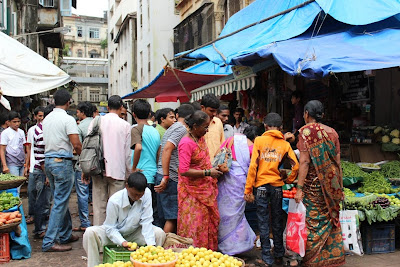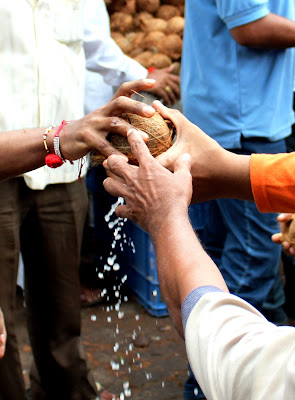- by Deepa Krishnan
Aishwarya and I went to Dharavi today, to meet some women who make papads. It was around 4:00 p.m., when we walked through one of the main bazaar areas. The street stalls were just beginning to be set up, with food for the evening iftar.
I could not believe the colour of the falooda packets that I saw - a pink so lurid that it would put all other pinks to shame :)

Amidst the lurid pink, were reds, oranges, yellows and greys

Foreground: Yellow Papayas
Behind: The falooda-man making take-home packets
The faloodas are really popular, so the vendor spends the afternoon tying them into little packets. In the evening, when the crowds assemble, he will have no time to do anything but hand over the packets (and count money)! Every few minutes, burkha-clad women would walk by and buy some to take home.
After the electric colours, the pale greens and muted yellows of the melons were very calming.

Just looking at these soft shades makes you feel cooler
Pineapples had been neatly peeled and the prickly bits had been taken out.

Pale yellow with dark green tops
Pomegranates add an exotic dash of maroon-pink to the fruits on sale. A mix of these fruits, sprinkled with chaat powder, will make a tangy, sweet way to break the fast.

Teen ka kitna? Lady in burkha taking three pomegranates home.
To add volume at low cost, bananas are added to the fruit chaat.

Ripe yellow with only vestiges of green

As if all this wasn't enough, watermelons and apples provide more colour!
There were lots of food stalls too, just beginning to be set up. The onion pakodas and kala-chana chaat counters were in place.

Adding orange and brown to the color-mix!
Usually the kala chana chaat is decorated with sliced tomatoes, and garnished with green coriander and lemon, but because it was early in the day, the presentation wasn't fully ready. But you can imagine it, can't you? :)
I saw people at little restaurants hard at work, setting up great big handis of mutton biryani, with coloured rice. At some counters, jalebis were being fried and dunked in sugar syrup. I couldn't see any of the famous kababs or indeed, any meat on hot griddles (tawas)...perhaps the griddles would only come later around sundown.
The chicken shops and meat shops were doing brisk business. This butcher stopped his thaka-thak-thwack for a little while to give me a smile.

Impressive heavy knife, making dull sounds on wooden meat counter. (Little bits of gristle would fly every time the knife came down. Not good for my vegetarian soul!)

These little boys had set up neem datoon stall.
Chewing the twigs releases chemicals in the plant that can kill bacteria and reduce the build up of plaque on the teeth. The neem datoon counters also sold lemons. I liked the contrast between the two colours, but couldn't understand why all the datoon stalls also sold lemons. Do you know? Is it because neem is bitter?

Meswak or Siwak is also used for cleaning teeth
(and tastes much, much nicer than neem!)
After the walk through the bazaar, we met some women, who were papad makers, to find out more about their life (material for another post perhaps!). By the time we finished chatting, another couple of hours had passed. We walked back through inside lanes to where the car was parked.
Because we came through residential twisting lanes, I didn't realize how much the bazaar area would transform in a couple of hours.
The crowd was incredible.

Our car in a sea of humanity
We inched further ahead, and found that the road was impossibly jammed with people. A handcart trundled to our left, piled high with suitcases (manufactured in Dharavi). As far as eye could see, the road was full of people.

We decided to stoically inch further ahead
By this time, I was standing with my entire torso outside the Innova, photographing the road :) It was quite an experience, actually, watching the crowd stream past, all intent on reaching home in time for prayer.

"Press walon ki gaadi hai" was the murmur in the crowd
(it's my new DSLR camera - everyone thinks I'm a professional! Whereas I can only point and click!).
After about 20 minutes of going through the dense crowd, we finally came out on the main road. I would have liked to get down and photograph the evening iftar meal. But it would have meant waiting for at least another 45 minutes. We were tired, it had been a long day already and I simply wasn't ready to jostle for photos. Besides, I had really enjoyed watching the lead up to the evening meal, and the ability to photograph all the vendors when they weren't going crazy dealing with the iftar rush.
I'm glad I could bring back these photos and post them. Hope you enjoyed them!










